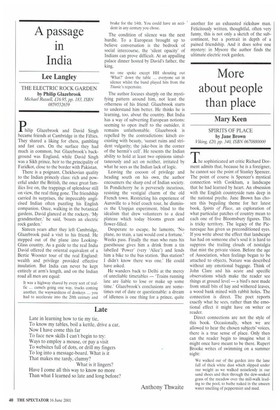More about people than place
Mary Keen
SPIRITS OF PLACE by Jane Brown Viking, £20, pp. 340, ISBN 0670880000 he sophisticated art critic Richard Dorment admits that, because he is a foreigner, he cannot see the point of Stanley Spencer. The point of course is Spencer's mystical connection with Cookham, a landscape that he had learned by heart. An obsession with the English countryside runs deep in the national psyche. Jane Brown has chosen this beguiling theme for her latest book, Spnits of Place, an exploration of what particular patches of country mean to each one of five Bloomsbury figures. This is tricky territory. The legacy of the Picturesque has given us preconditioned eyes. If you write about the effect that landscape has had on someone else's soul it is hard to suppress the trailing clouds of nostalgia that mist the private vision. Before the age of Association, when feelings began to be attached to objects, Nature was described without any emotional baggage. Think of John Clare and his acute and specific observations which make the reader see things at ground level — a bird's nest made from small bits of hay and withered leaves, a wood bank mined with rabbit holes. The connection is direct. The poet reports exactly what he sees, rather than the emotional effect it might have on writer or reader.
Direct connections are not the style of this book. Occasionally, when we are allowed to hear the chosen subjects' voices, there is a true sense of place. Only then can the reader begin to imagine what it might once have meant to be there. Rupert Brooke writes of swimming on a summer night:
We walked out of the garden into the lane full of thick white dust which slipped under our weight as we walked noiselessly in our sand shoes and then through the dew-soaked grass of the meadow over the mill-walk leading to the pool, to bathe naked in the unseen water smelling of peppermint and mud.
L. P. Hartley describes the sluice gates in the Fens where 'the drains and dykes moved in slow motion' and Carrington recalls her first sight of Ham Spray I-fouse under the Downs,
a ramshackle lodge, a long avenue of limes but all withering in appearance, bleak and the road a grass track. Barns in decay, then the back of a rather forbidding farm house,
but these evocations of particular landscapes are rare. There is so much that comes between the spirits and their places that the reader often loses all sense of direction.
Virginia Woolf s sensibilities to the wonders of St Ives come heavily loaded, and are delivered third-hand. Woolf s words are notably absent, although Jane Brown does provide footnote references to quotations from the novelist. Instead we read of painters who set up their easels during her 'childhood Eden' by the sea.
Thomas Millie Dow painted ethereal spiritual seascapes (such as Virginia might later have described) to make you creep with the strong quietness and mystery of nature pictures that touch us as a summer evening touches us, as a melody heard over still water.
These words of Tom Cross from Painting the Warmth of the Sun come filtered through Jane Brown's own perceptions. They are intended to provoke an emotional reaction, to appeal to the reader's personal images and memories of seaside holidays. Virginia Woolf is barely given the chance to engage with St Ives.
This is not a work about place, so much as about people. Bloomsbury gossip at the gallop was the point of the book for me. Jane Brown is addicted to research, which she delivers in a breathless torrent of tiny vignettes: Rupert Brooke using a chest expander, Maynard Keynes weeding in approved Kipling mode, with a broken dinner knife, David Cecil reading Keats in a gondola, L. P. Hartley in a woolly jumper and a crumpled suit. We learn that Constance Gamett's chairs were covered in peacock blue and hear Forster on life as a tutor to Elizabeth of German Garden fame. This style of writing, the Kim's Game approach, will be anathema to some. I rather enjoy the haphazardness of it all. We leap from David Garnett studying medical biochemistry in London to tennis and croquet in Surrey 40 years later, then float past a sentence about Duncan Grant, 'Bloomsbury's most seductively, mischievously, homosexual treasure' and on to be catapulted into Constance Garnett's pacifism and her 'publication of seven fat volumes of Dostoevsky'. As always, the web of Bloomsbury lives is riveting stuff, but of Jane Brown's aim to present her characters as people 'motivated by their own surroundings, leaving memories and legends in our landscape' this reader was not persuaded.



































































 Previous page
Previous page